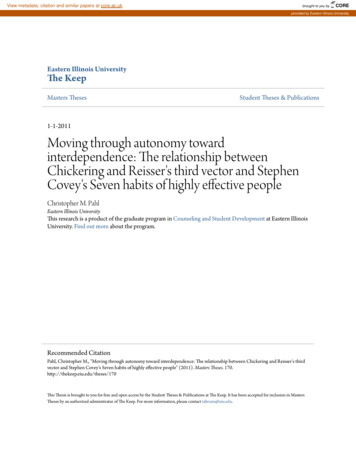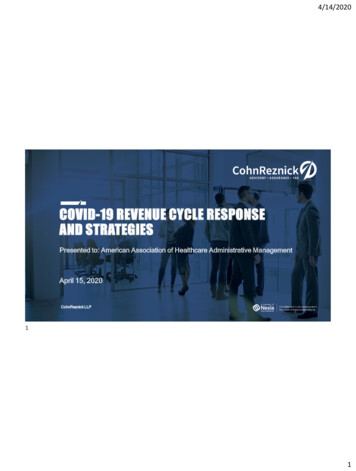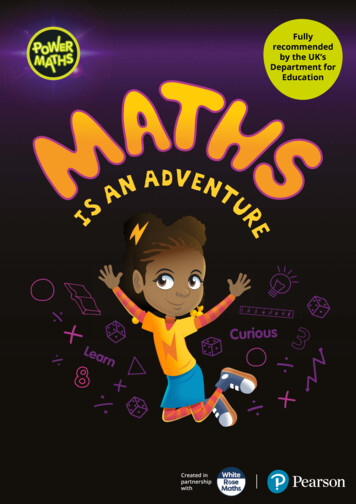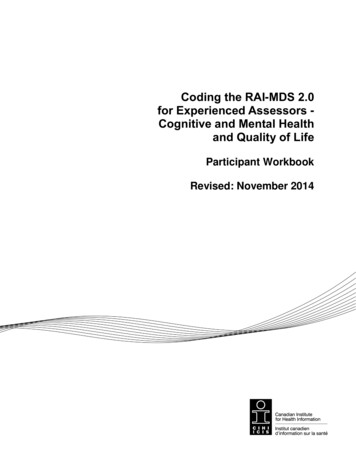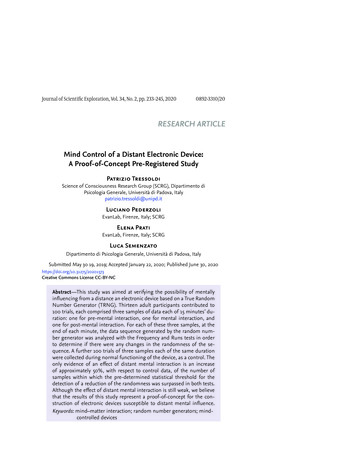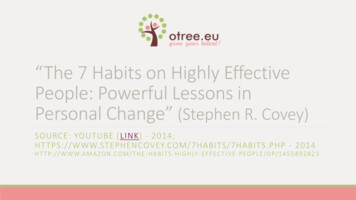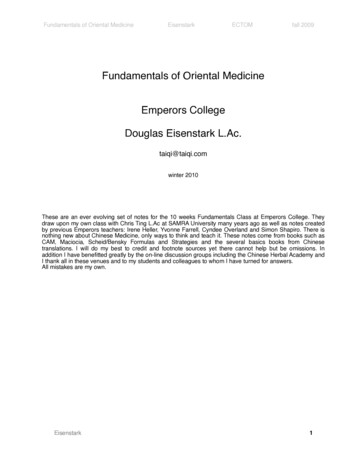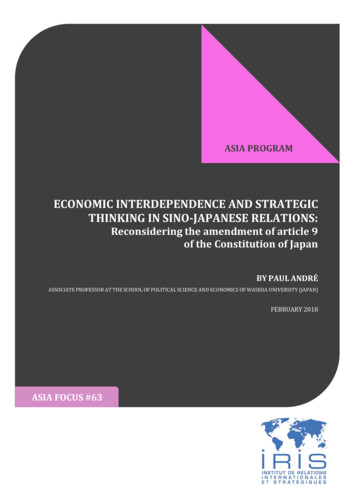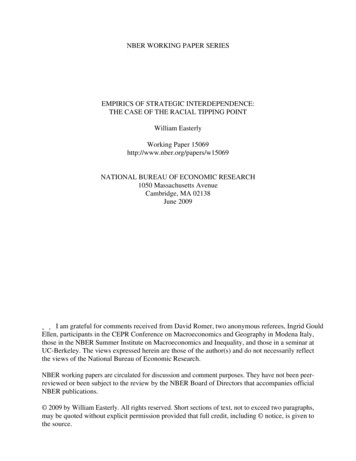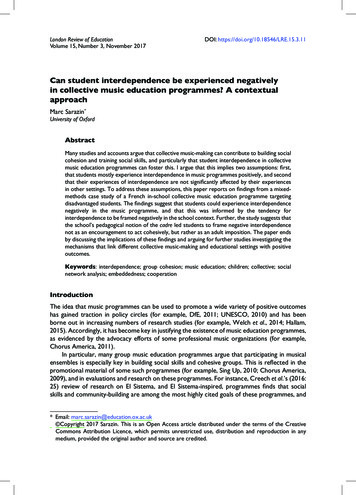
Transcription
London Review of Education Volume 15, Number 3, November 2017DOI: https://doi.org/10.18546/LRE.15.3.11Can student interdependence be experienced negativelyin collective music education programmes? A contextualapproachMarc Sarazin*University of OxfordAbstractMany studies and accounts argue that collective music-making can contribute to building socialcohesion and training social skills, and particularly that student interdependence in collectivemusic education programmes can foster this. I argue that this implies two assumptions: first,that students mostly experience interdependence in music programmes positively, and secondthat their experiences of interdependence are not significantly affected by their experiencesin other settings. To address these assumptions, this paper reports on findings from a mixedmethods case study of a French in-school collective music education programme targetingdisadvantaged students. The findings suggest that students could experience interdependencenegatively in the music programme, and that this was informed by the tendency forinterdependence to be framed negatively in the school context. Further, the study suggests thatthe school’s pedagogical notion of the cadre led students to frame negative interdependencenot as an encouragement to act cohesively, but rather as an adult imposition. The paper endsby discussing the implications of these findings and arguing for further studies investigating themechanisms that link different collective music-making and educational settings with positiveoutcomes.Keywords: interdependence; group cohesion; music education; children; collective; socialnetwork analysis; embeddedness; cooperationIntroductionThe idea that music programmes can be used to promote a wide variety of positive outcomeshas gained traction in policy circles (for example, DfE, 2011; UNESCO, 2010) and has beenborne out in increasing numbers of research studies (for example, Welch et al., 2014; Hallam,2015). Accordingly, it has become key in justifying the existence of music education programmes,as evidenced by the advocacy efforts of some professional music organizations (for example,Chorus America, 2011).In particular, many group music education programmes argue that participating in musicalensembles is especially key in building social skills and cohesive groups. This is reflected in thepromotional material of some such programmes (for example, Sing Up, 2010; Chorus America,2009), and in evaluations and research on these programmes. For instance, Creech et al.’s (2016:25) review of research on El Sistema, and El Sistema-inspired, programmes finds that socialskills and community-building are among the most highly cited goals of these programmes, and* Email: marc.sarazin@education.ox.ac.uk Copyright 2017 Sarazin. This is an Open Access article distributed under the terms of the CreativeCommons Attribution Licence, which permits unrestricted use, distribution and reproduction in anymedium, provided the original author and source are credited.
London Review of Education 489that ‘many researchers [have] attributed [their development] to learning through ensemble’.Likewise, Chorus America’s (2009) impact study focuses on how choirs help build school andneighbourhood communities, and train social skills alongside academic skills.These claims are bolstered by academic studies that find that music-making in groupspromotes social cohesion, well-being and the training of social skills (for example, Bittman etal., 2003; Rabinowitch et al., 2013; Schellenberg et al., 2015; Kirschner and Tomasello, 2010; seealso Hallam, 2015). However, many of these studies seem to elide the variety of experiences andsocial dynamics that can exist in different collective music-making settings. Although they studyparticular group music-making set-ups in specific contexts, they often conclude that collectivemusic-making generally leads to positive outcomes. In fact, they use many different terms torefer to music-making in groups, even though they do not seem to use them to mean differentthings. This suggests a lack of understanding of different group music-making set-ups and thedifferent benefits they can bring. Further, some studies do not specify the mechanisms throughwhich the particular activities that they study lead to positive outcomes. When such mechanismsare specified (for example, Rabinowitch et al., 2013; Koelsch et al., 2010), they often link groupmusic-making generally with positive outcomes, ignoring the different dynamics that arise indifferent situations. This suggests a further dearth of understanding in how different kinds andcomponents of group music-making, and related educational programmes, can contribute topositive social outcomes.One such component that is under-studied is interdependence between musicians. Manyadvocates of group music learning argue that it enables the learning of social skills and thebuilding of positive communities. Govias (2011: 22) claims that ‘the collaborative, interdependentenvironment of the ensemble’ is a fundamental part of El Sistema music education programmes, asit helps students ‘build and model the cooperative attributes of a healthy symbiotic community’.Likewise, Billaux (2011) claims that interdependence itself is key to understanding the benefitsof El Sistema, in particular in terms of gaining social skills. Finally, Booth (2011: 22) describesthe orchestra as an ‘interdependent’ community, which is key to the social impact of El Sistemaprogrammes.Although these accounts often do not fully explicate what interdependence means, theyseem to suggest that it involves being in a group that is important in musicians’ lives andwhere musicians depend on each other, in that each musician is essential for achieving thegroup’s shared goals. Some researchers argue that this kind of interdependence is important inpromoting social outcomes. For instance, Koelsch et al. (2010) argue that part of the power ofcollective music-making lies in the cooperation towards shared goals that it entails. They arguethat this contributes to shared pleasure and group social cohesion. Research into perceivedsense of community (McMillan and Chavis, 1986), including in educational settings (Osterman,2000; Battistich et al., 1995), advances similar arguments. It finds that communities need to bean important part of individuals’ identity, and that individuals need to feel both influential andneeded in their community, for a positive sense of community to emerge.Arguing that such interdependence leads to positive social outcomes in collective musiceducation programmes implies two things. First, it implies that students in these programmesexperience interdependence positively. Second, it suggests that this interdependence is somehowunique, or at least that students’ experiences of interdependence are not closely relatable tosimilar experiences elsewhere.However, some studies problematize these assumptions by arguing against the unique andtransformative effects of interdependence in ensembles. Studies of symphony orchestras – inmany ways the epitome of the interdependent musical ensemble – suggest that these groupsfoster competition and tension as opposed to cooperation between musicians (Faulkner, 1973a;
490 Marc SarazinBaker, 2014). They further find that any interdependence that may exist between orchestralmusicians is almost entirely mediated by authoritarian conductors (Faulkner, 1973b; Tindall,2005; Baker, 2014; Levine and Levine, 1996; Cottrell, 2004).Many differences exist between collective music education programmes and professionalorchestras. However, these studies suggest that more research is needed to understandstudents’ experiences of interdependence in programmes that aim to build social skills andgroup cohesion through group music-making. Indeed, theories of how social relations affectindividuals remind us that being embedded in groups can have complex effects, including notonly enhancing individuals’ agency but also providing constraints (Borgatti and Halgin, 2011; Lin,2001).The present study investigates the experiences of interdependence of students in suchprogrammes. Is it possible for interdependence to be experienced negatively by students incollective music education programmes? And do possible experiences of interdependence inother contexts inform students’ experiences of it in music programmes? Neglecting to ask thesecritical questions about the contexts and processes of social impact can lead to the idea, rightlyproblematized by Baker (2016: 24), that ‘positive social action happens automatically whenpeople make music together’, and to silencing the voices of participants in favour of blanketstatements on the power of collective music-making (Bergh and Sloboda, 2010).I seek some answers to these questions through a case study of a French in-schoolcollective music education programme and its wider primary school context. The programme isparticularly interesting as it emphasized building group cohesion and effectively created studentinterdependence, and as it was linked to a wider educational context that also aimed to buildsocial cohesion and improve students’ social skills. After describing the case and study, I look atinterdependence in the music programme and how it was experienced by students. I then lookat interdependence in the programme’s school context and how it may have informed students’experiences in the programme. I end by discussing the implications of the study’s findings.Study designThis paper draws on findings from a study whose purpose was to investigate the mechanismsbehind students’ social experiences in collective music education, and to relate these to students’broader educational experiences and outcomes. As an amateur musician and interdisciplinarysocial scientist with a background in education, sociology, social psychology and anthropology, Iwas enthusiastic about the potential for collective music-making to promote positive outcomes.However, as mentioned above, I was keen to look at specific aspects of particular music-makingset-ups in depth. I was also open to investigating both the positive and unintended effects ofgroup music education, particularly as I felt that the problematic effects of these were understudied (see also Boeskov, 2017; Kertz-Welzel, 2016).I therefore decided to further knowledge on this topic through a mixed-methods embeddedcase study (Yin, 2014) of a particular collective music education programme in two primaryschools in a large French city. Both schools were going through the first year of the programme.The intervention was spearheaded by one of the schools, which became the main focus of thestudy. This school is the source for all the results presented here.The school was a private primary school (for students aged 5 to 12) run by a large Frenchcharitable foundation. It had under fifty students, with some students starting at and leavingthe school throughout the year, and approximately thirty members of staff in regular contactwith the students. Most members of staff participated in the study, and all students except oneparticipated in the study. Its mission was to increase the self-esteem and academic achievement
London Review of Education 491of students from disadvantaged backgrounds or who had experienced difficulties in their previousschooling. As such, over 20 per cent of the students at the school were known to social services,and half of the students had already repeated a year of schooling.The school was unusual in the French educational context in that, compared to otherschools and in relation to its mission, it had a relatively strong focus on working on students’éducation (understood as the non-academic aspects of learning how to live in society) alongsidetheir academic learning (see Nique and Lelièvre, 1993; Muller, 1999). Particularly relevant for thisstudy, this included improving students’ ability to vivre en collectivité (live collectively), a conceptsimilar to social skills. Related to this, one of the primary aims of the music programme in theschool was to help build social cohesion between students in the school, alongside improvingstudents’ social skills. The school also had boarding houses, accommodating over half of thestudent population, to further pursue these goals.The music programme under study was a music education programme involving collectivelearning of mostly classical music in groups of 10 to 15 students. These groups combined withother such groups to perform as an orchestra in an end-of-year concert, to which families,sponsors and local dignitaries were invited. The school contained three such music groups, eachwith a particular family of instruments. Although the programme had already been deployedin other settings, it had an experimental ethos and gave relative pedagogical freedom to itsteachers. The programme took place after school hours and replaced previous extra-curricularactivities in the school. Participation in the programme was mandatory for the students.I carried out ethnographic fieldwork in the school and programme between mid-September2015, six weeks before the start of the music programme, and the end of the school year in July2016. I decided to use ethnographic methods to ‘physically and ecologically penetrate [students’]circle of response to their social situation’ (Goffman, 1989: 125) and understand students’ socialexperiences ‘in all [their] various layers of social meaning’ (Woods, 1986: 5). As a Frenchmanwho had not experienced primary education in France, I chose to study a French primary schoolin a city that was not known to me, to experience ‘strange-ness’ in the school and its contextwhile minimizing linguistic barriers.I also carried out two rounds of quantitative measures in the school, one just before thestart of the programme (October 2015), and one 5 to 6 months after its start (March/April2016). I used these methods to obtain quickly a broad picture of students’ opinions, attitudesand social relations in the school over time. They also served to focus my qualitative sampling,for instance on groups with different network configurations.This findings of this paper arise principally from data obtained through overt participantobservation and semi-structured interviews. The former was the ‘central method’ of myethnographic fieldwork (Delamont, 2002: 7). It consisted of participating as a learner in musiclessons, and playing and interacting with students during break periods and in boarding houses.I tried as much as possible to be subjected to the same rules as the students. I adopted aform of ‘least adult’ role (Mandell, 1988), engaging in joint action with students in order tobuild relationships with them while reducing power differentials that are often problematic inresearch with children (Fargas-Malet et al., 2010; Kirk, 2007). However, my age still markedly setme apart from the students. This sometimes made it difficult for me to gain a legitimate presencein student-centred spaces (see Sim, 2016), although it also made it possible for me to use myage difference to ask naive questions (see O’Reilly, 2009). Likewise, my gender had a substantialimpact on how students interacted with me, and so on the relationships that I was able to buildand data I was able to obtain throughout my fieldwork.I concurrently carried out ethnographic observations in a systematic fashion (Delamont,2002; Delamont, 2008) and frequently took breaks from participation to write up field notes.
492 Marc SarazinI did this to document ‘social life as process’ (Emerson et al., 1995: 14) in a ‘microscopic’manner (Geertz, 1973: 20), focusing on students’ behaviours and interactions. I then wrote upthese notes as soon as possible out of the field (Delamont, 2002; Delamont, 2008; Hammersleyand Atkinson, 2007). I ended up writing close to 500,000 words of notes from an estimate ofapproximately 700 hours of participant observation.My observations were informed by a theoretical view of children as agents trying to shapetheir complex social worlds (James and Prout, 1997; Allan and Catts, 2012; Morrow, 1999;Schaefer-McDaniel, 2004; Weller, 2010). I combined this perspective with principles from socialnetwork theory, social capital and relational sociology addressing how social relations enableand constrain individuals and how individuals use these to pursue their goals (Borgatti andHalgin, 2011; Borgatti et al., 2013; Emirbayer and Goodwin, 1994; Lin, 2001).The findings below also draw on approximately forty group and individual semi-structuredinterviews with students, lasting 20 minutes on average. I adopted Rubin and Rubin’s (2005)‘responsive interviewing’ approach for these interviews. This approach recommends seeinginterviewees as ‘conversational partners’ (2005: 14). It emphasizes interviewees and researchersworking together to co-shape interviews and achieve shared understandings revolving aroundboth the researcher’s and the interviewee’s concerns. I thus asked students about their socialrelations and their experiences and opinions of the school and music programme, while alsodiscussing topics that students raised for discussion. I also carried out child-friendly interviews,including storytelling interviews (Davis, 2007; Eiser et al., 1990) where I provided students witha title for a fictional story related to the topics above. Students then told a story suggested bythe title. The purpose of these interviews was to access representations of students’ culturalmodels and figured worlds (Gee, 1999; Holland et al., 1998). In the interview excerpts reportedhere, I have omitted hesitations and pauses where these did not add substantial meaning. Alltranslations from French are my own.The social network findings presented below arise from individual structured interviewswith students that I carried out during the two quantitative measurement rounds. During theseinterviews, I asked students to nominate their friends, among other social relations, using thename generator method (Borgatti et al., 2013).All participants were aware of my identity as a researcher. Members of school staff and otheradults could give consent directly to participate in the study, while parents were responsiblefor giving consent for their child’s participation. Nonetheless, I also sought students’ assent forintensive methods, such as interviewing, questionnaires and recordings, and systematically askedschool staff’s consent before carrying out observations in their lessons. I also sought to minimizepossible social risks for students arising from collecting social network data, namely by holdinginterviews in private locations out of earshot of other school members (see Asher et al., 2014).I promised anonymity and confidentiality to all my study participants and institutions, soall names used in this paper are pseudonyms. I also sought respondent validation by presentingearly versions of the findings to the staff and management of both the school and the musicprogramme. While some staff members broadly recognized the dynamics presented here, theyalso emphasized that this was a partial account of students’ social experiences in the musicprogramme and school, and that the findings only concern the period before the end-of-yearconcert, before the students’ collective hard work had come to fruition. Indeed, the concertoccurred at the very end of my fieldwork. Therefore, I emphasize that this paper is not acomprehensive account of students’ social experiences, and that these could certainly be positive,including with regard to the interdependence that I argue was created. Rather, its purpose is toilluminate certain processes that are interesting in view of the gaps in understanding outlinedabove.
London Review of Education 493Interdependence in the music programmeBuilding cohesion within music groups was a key aim of the programme. For the programme’sleadership, it was not only essential for motivating students in their learning, it was also key forachieving the school’s aims of building cohesion across the school and improving students’ socialskills and éducation. Indeed, the school decided to mix students from different school classesin the same music groups. This way, it hoped students’ social experiences in the music groupswould help them establish positive relations with students from other classes, thus buildingcross-school cohesion and teaching students to cooperate and construct positive relations witha variety of individuals.Although this was not always intended, in trying to build group cohesion, the programmesometimes put in place strategies which effectively created interdependence between students.Many of these strategies involved helping students realize that they were all essential for theirgroup, including in contributing to their group’s goals. This included making different instrumentsplay different parts in each music group, each instrument contributing to a harmonic whole. Italso included giving students an instrument to take home with them on loan, but only if everystudent in their music group was considered ‘ready’.However, it soon became clear that students could be aware of and resent theinterdependence that was created between them. This was especially evident in the Strings Bgroup regarding the issue of taking instruments home. The group was unusual in that there wererelatively few friendships within it at the beginning of the music programme (see Table 1).Table 1: Friendship densities in the different music groups throughout the year (friendship densityis defined as the number of friendships divided by the possible number of friendships in a group; onlystudents who attended the school at both measurement waves are included)All friendshipsReciprocated friendshipsNumber ofstudentsWave 1(Oct 2015)Wave 2(Mar/Apr2016)Wave 1(Oct 2015)Wave 2(Mar/Apr2016)Strings B140.1590.1590.0550.022Strings .256Of whichFlutes60.1670.4670.0670.267Table 1 shows that the density of friendships – in other words, the number of friendships asa proportion of the total possible number of friendships – in the Strings B group was only0.16, whereas it was at least 0.26 in the other two groups. This differential was even larger forreciprocated friendships – friendships where both students said that they were friends – whichsome argue are a stronger and more reliable indicator of interpersonal affinity among children(Berndt and McCandless, 2009; Newcomb and Bagwell, 1995). Further, a visualization of thefriendship network of the group at that period shows that all reciprocated friendships arosebetween students in the same class (see Figure 1). Overall, this suggests that building cohesionin the group, especially across school classes, would be difficult, raising the question of whetherinterdependence would achieve this.
494 Marc SarazinFigure 1: Reciprocal friendship network of the Strings B group during the first wave ofquantitative measurements, before the music programme started (colours indicate the schoolclasses of the students)Lessons were relatively laborious in the group, and it quickly became known by staff membersas a particularly difficult group. Consequently, as a way of motivating students to improve theirbehaviour, programme staff reminded students that they would be able to take their instrumentshome only when they were collectively ‘wanting to learn’. They intimated that poor behaviour inthe group would lead them to think that the group was not ready to receive their instruments.This made students interdependent – the collective goal of taking instruments homedepending on each student’s behaviour, which was soon contested by some students. Thefollowing interview with Shane [male, Year 6] demonstrates this. The interview took place theday after a lesson in which staff members had made a reminder about the conditions for takinginstruments home. Shane had reacted by telling them that they should make lists of studentswho were and were not well-behaved. I asked him to expand on this in the interview:Shane:Yes, those who are disruptive, and who don’t want to learn, well, we [should] write[their names] down. For example, Matteo, he listens; me, I listen; Francesco, he doesn’tlisten; Michael, uuhhm, in the middle. There. We [should] make a list; those who wantto learn are trusted and can bring their instruments home.This excerpt suggests that, for Shane, his interdependence with other students is illegitimate.In the following weeks, students increasingly complained about not receiving their instruments,protesting that the staff members were not treating them fairly. The following vignette, takenfrom field notes from a music lesson two days after the above interview, shows this well:Lucy [the programme’s local administrative lead] comes in early in the lesson, saying she hasan announcement to make. In a firm voice she says, ‘I’m not happy with this group, I’m toldthat there is a problem here, I keep hearing [negative] things about you, and I would like youto be moving forward.’ The room quietens down. Lucy says, ‘regarding when you will get yourinstruments’ – students’ faces brighten, namely Francesco’s [male, Year 6] and Shane’s – she says,‘it’s up to you’. She says she doesn’t know when they will get their instruments, but the StringsA group will be getting theirs in a few weeks. The second she mentions this, Shane, Francescoand Michael [male, Year 6] exclaim ‘Come on!’, flinging their arms in front of them in indignation.Shane gets up immediately and starts putting his instrument away. Lucy asks him if he will sit
London Review of Education 495down with everyone else. Shane: ‘We aren’t trusted, I’d rather focus on my future career thanplay an instrument.’Crucially, this vignette suggests that students did not see the interdependence that adultseffectively created between them as an opportunity to ‘think as a group’ and collectively manageeach other’s behaviour, as some accounts argue might happen (for example, Govias 2011).Rather, it suggests that they saw it as unfair treatment in favour of the Strings A group. Thisinstance therefore shows how student interdependence could not only be perceived negativelybut also act against the building of the group cohesion that was so important in the case of theprogramme. In fact, there was relatively little growth in friendships – both reciprocated and nonreciprocated – in the group in the first six months of the programme. Of course, this is likelydue to a complex range of factors. However, it suggests at minimum that the cohesion that themusic-making was supposed to create had not yet materialized, even after most of the schoolyear (see Table 1).The vignette also shows how students’ perceptions could lead to fierce behaviouralreactions. In fact, Strings B lessons became increasingly laborious that month. Tensions reacheda climax three weeks later, when Michael [male, Year 6] and Shane (both students whom theadults thought could drive the rest of the group forward if they wanted to) categorically refusedto participate in a music lesson. This led Julie, the programme’s pedagogical lead, explicitlyto ask the students why they were acting so uncooperatively. Some of the reasons that thestudents gave – including being unable to change instruments because some instruments weretoo popular among other students, or the slow progress of lessons due to the need to wait forother students to be silent – also suggested that they resented depending on other students.Although in this instance the interdependence created between students was relativelyexplicit, it was also created more implicitly, through the programme’s policies of giving primacyto group learning and avoiding excluding disruptive students from lessons. Instead, musicteachers were instructed to tell these students ‘we need you’. The phrase, like the policies,both reified the music groups as unified entities and emphasized that each student was crucialfor their group. By extension, they suggested that students also needed other students in theirgroup, and so represented a more implicit form of interdependence.Crucially, ‘needing others’ could entail very different experiences for students to whatwas intended by staff members. A vignette from an unusually tumultuous beginning of a flutelesson within the woodwind group demonstrates this well. The lesson occurred at a time whenstudents were familiarizing themselves with their instruments and learning how to assemblethem. It arose after a string of difficult lessons. This made Julie decide to attend the lesson toassist in its running:Camille [the flute teacher] asks the students to get in a circle, take out their mouthpieces andblow into them, one at a time, clockwise around the circle. When Melanie [female, Year 4], whois second, blows, Sonny [male, Year 5] and Federico [male, Year 4] comment on how the soundsshe makes are horrible. The next student plays, and suddenly noises come from several othermouthpieces. This lasts for a few seconds, until an adult tells everyone to stop. Camille starts theactivity again, this time going anticlockwise. However, by the time Melanie plays again – the boysonce again make fun of her sounds – the noise has risen again. Julie thus tells the students to stopand put their mouthpieces down. However, Sonny refuses, arguing that Kayley [female, Year 3]has not put hers down either. Julie tries to reason with him for the next five minutes, while therest of the group wait. Eventually, Camille decides to help students individually assemble theirflutes. While she does this, other students have got up and are walking around the room makingloud, shrill noises with their flutes. Federico goes to the microwave at the side of the room andmakes it ‘ding’, exclaiming ‘Just making my coffee!’ A cacophony of noises emerges. After severalminutes, Melanie storms out of the ro
people make music together', and to silencing the voices of participants in favour of blanket statements on the power of collective music-making (Bergh and Sloboda, 2010). I seek some answers to these questions through a case study of a French in-school collective music education programme and its wider primary school context.
